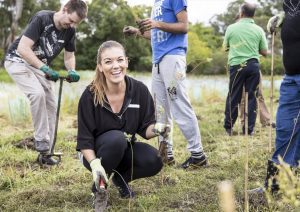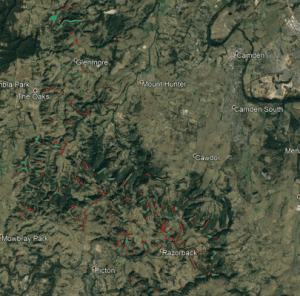
The Western Sydney Dry Rainforest is little known or appreciated.
It is also listed as a critically endangered ecological community.
According to Greening Australia, which has developed a plan to restore it, WSDR is a plant community that stretches from Macarthur’s backyard to the Hawkesbury.
Locally it occurs in Camden near Cobbitty and on the Razorback Mountain in the Wollondilly Shire.
It’s essentially a dry vine scrub community of the Cumberland Plain and typically occurs in gullies and on sheltered slopes of hilly, steep country.
Because a high proportion of it occurs on private property, Greening Australia will engage a minimum of 10 land holders on properties containing WSDR across Camden and Wollondilly Local government areas.
The project, Restore and Reveal Western Sydney Dry Rainforest, will be funded by the NSW Environmental Trust.
[social_quote duplicate=”no” align=”default”]“Our objectives are to engage the community, reduce woody weeds, reduce habitat fragmentation and revegetate areas where woody weeds have been removed,’’ says Nathan Green, community and education programs coordinator of Greening Australia.[/social_quote]
“An outcome of the project is to propagate 4,000 seedlings to be planted on participating landholders’ properties,’’ he said.
WSDR is generally characterised by rainforest vine thickets and a canopy of prickly paperbark, native quince and hickory wattle and a diverse rainforest understorey of native olives, hairy clerodendrums and yellow pittosporum.
Dry rainforest is a low closed forest with the occasional emergent gum tree, however disturbance from partial clearing and urban development mean that WSDR may now exist as woodland or shrubland.
“An experienced habitat restoration ecologist from Greening Australia can meet you on your property and discuss opportunities regarding the management of your bushland,’’ Mr Green said.
“We will identify WSDR plant species and threats to its wellbeing.
“Greening Australia staff will then develop management actions for the site that will aim to improve the condition of WSDR and the native animals that live there,’’ he said.
“This plan will be developed by Greening Australia in collaboration with the landholder.’’

Participating landholders will receive the use of motion sensing wildlife cameras to identify what animals are currently using their patch of WSDR.
This will feed into the following tailored vegetation management plan:
- management actions for control of feral animals and promotion of native fauna;
- management of woody and herbaceous weeds;
- actions to Improve quality and extent of WSDR;
- access to weed control and management resources free of cost. These may include expertise, herbicide, regen kits, local provenance plants, planting materials and the use of wildlife cameras.
Subsequent training sessions will be offered to consolidate landholder skills and create showcase managed WSDR sites.
Workshops will look at a number of issues, including the use of motion sensing wildlife cameras, weed control techniques, seed collection and regeneration techniques
If you think your land contains Western Sydney Dry Rainforest and would like to take part in the project, contact project manager Dave Warren via email, DWarren@greeningaustralia.org.au or phone 9677 6200 and Nathan Green via email, ngreen@greeningaustralia.org.au or phone 9677 6200.




Jarrod Alchin